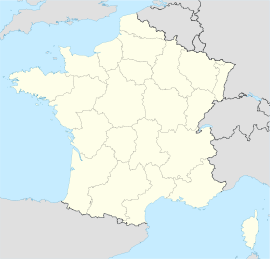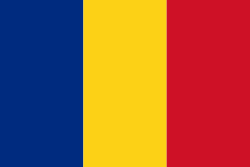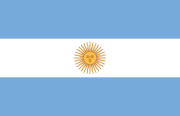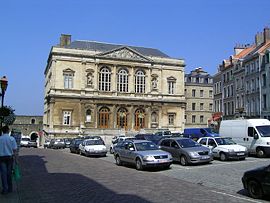Boulogne-sur-Mer
|
Commune of Boulogne-Sur-Mer |
|
| Location | |
 Boulogne-sur-Mer
|
|
| Administration | |
|---|---|
| Country | France |
| Region | Nord-Pas de Calais |
| Department | Pas-de-Calais (sous-préfecture) |
| Arrondissement | Boulogne-sur-Mer |
| Canton | Chief town of 3 cantons |
| Intercommunality | Boulogne Côte d'Opale |
| Mayor | Frédéric Cuvillier (2001-2008) |
| Statistics | |
| Land area¹ | 8.42 km² |
| Population² (1999) |
44,859 |
| - Density | 5,327.7/km² (1999) |
| Miscellaneous | |
| Postal code | 62200 |
| 1 French Land Register data, which excludes lakes, ponds, glaciers > 1 km² (0.386 sq mi or 247 acres) and river estuaries. | |
| 2 Population sans doubles comptes: residents of multiple communes (e.g., students and military personnel) only counted once. | |
Boulogne-sur-Mer (Bonen in Dutch) is a City in Northern France. It is located in the département of Pas-de-Calais (it has the status of subprefecture), near the English Channel.
The population of the city (commune) was 44,859 in the 1999 census, whereas that of the whole metropolitan area (aire urbaine) was 135,116.
Contents |
Name
The name Boulogne was first recorded during the Roman Empire as Bononia, a derivative of the Celtic word bona (meaning "foundation", "settlement", "citadel"). This derivation is also found in the name of the Italian city of Bologna.
History
Origin of the city
Originally named Gesoriacum and probably also to be identified with Portus Itius, by the 4th century Boulogne was known to the Romans as Bononia and served as the major port connecting the rest of the empire to Britain. The emperor Claudius used this town as his base for the Roman invasion of Britain, in AD 43, and until 296 it was the base of the Classis Britannica.
Middle ages
In the Middle Ages it was the centre of a namesake county. The area was fought over by the French and the English. In 1550, The Peace of Boulogne ended the war of England with Scotland and France. France bought back Boulogne for 400,000 crowns.
The Napoleonic period
In the 19th century the Cathedral of Notre Dame was reconstructed by the priest Benoit Haffreingue after he received a call from God to reconstruct the town's ruined basilica. During the Napoleonic Wars, Napoleon amassed La Grande Armée in Boulogne to invade the United Kingdom in 1805. However, his plans were halted by other European matters and the supremacy of the Royal Navy.
The two world wars
Post war to present
Economy
Boulogne-sur-Mer is the most important fishing port in France. 7,000 inhabitants derive part or all of their livelihoods from fishing.
IFREMER (the French Research Institute for Exploitation of the Sea) and the Pasteur Institute are located in Boulogne Port.
Certain brands, including Crown and Findus, are based in Boulogne.
Media
- Radio : Radio 6, France Bleu Nord, Virgin Radio Côte d'Opale.
- Television : France 3 Côte d'Opale
- Print : La Voix du Nord (édition de Boulogne sur Mer), La Semaine dans le Boulonnais, Touzazimut.
Miscellaneous
Opened in 1991, Nausicaä - The French National Sea Centre is a Science Centre entirely dedicated to the relationship between Mankind and the Sea. It houses Aquaria, exhibitions on the marine fauna, and the exploitation and management of marine resources (fisheries, aquaculture, coastal planning, maritime transport, exploitation of energies and mineral, tourism).
In the year 1905 the First Esperanto Universal Congress was held in Boulogne-sur-Mer. L. L. Zamenhof, the creator of Esperanto, was among the attendees. In the year 2005 there was held a great anniversary meeting with more than 500 attendees.
Administration
- Boulogne is the main city of the Communauté d'agglomération du Boulonnais
| Duration | Name | Party | Particularities |
|---|---|---|---|
| 2008-2014 | Frédéric Cuvillier | PS | Deputy |
| 2004-2008 | Frédéric Cuvillier | PS | Deputy |
| 1996-2004 | Guy Lengagne HI | PS | Deputy |
| 1989-1996 | Jean Muselet | Conservative | |
| 1977-1989 | Guy Lengagne | PS | Deputy, Minister |
| 1945-1977 | Henri Henneguelle | PS | |
| Past mayors are unknow. | |||
Population
| 1936 | 1954 | 1962 | 1968 | 1975 | 1982 | 1990 | 1999 | 2006 |
|---|---|---|---|---|---|---|---|---|
|
52 371 |
34 885 | 49 283 | 49 288 | 48 440 | 47 653 | 43 678 | 44 859 | 43 700 |
Transport
Road
- Metropolitan bus services are operated by the TCRB
- Coach services to Calais and Dunkerque
- A16 Motorway
Rail
- The main railway station is Boulogne-Ville and located in the south of the city.
- Boulogne-Tintelleries is used for regional transit, located near to the University and the city center
Water
- The ferry service between Boulogne and Dover has been operated by SpeedFerries since the closure of Hoverspeed.
- The major port of Calais is only 30 km away and provides major connections to Dover in England.
Air
Education

Boulogne sur Mer is famous for hosting one of the oldest Universités de l'été - summer courses in French language and culture.
The Saint-Louis building of the University of the Côte d'Opale's Boulogne campus opened it's doors in 1991, on the site of the former St. Louis hospital, the front entrance to which remains a predominant architectural feature. Its 6 major specialisms are Modern Languages, French Literature, Sport, Law, History and Economics. The University is situated in the town centre, about 5 minutes from the Boulogne Tintelleries train station.
University
- University : University of the Littoral Opal Coast (Saint-Louis, Grand-Rue and Capérure site)
Public primary and secondary
- High Schools : Lycée Edouard Branly, Auguste Marriette, Giraux Sannier, Cazin (professional).
- College : College Langevin, Angelier, Daunou.
Private primary and secondary
- High Schools : Lycée Nazareth, Haffreingue, Saint-Joseph (professional).
- College : College Godefroy de Bouillon, Haffreingue, Nazareth, Saint-Joseph.xc
Entertainment
There is one theatre, the Théatre Monsigny and two cinemas.
Health
Two Health centers are located in Boulogne. The public Hospital Duchenne and the private Clinique de la côte d'opale
Sports
Football
- US Boulogne Côte d'Opale (Ligue 2)
- Aiglons
Basketball
- Stade Olympique Maritime Boulonnais (Nationale 1)
- ESSM (Pro B) located in Le-Portel.
Others Sports
- Aviron Boulonnais, produce many olympic medals for France
Culture
- The castle-museum of Boulogne, in the fortified town, houses the most important exhibition of masks from Alsaka in the world, the second largest collection of Greek ceramics in France (after the Louvre), collections of Roman and medieval sculptures, paintings (15th-20th century), an Egyptian collection, African Arts etc. As these collections are exhibited in a medieval castle, one can also discover the Roman walls (in the underground) as well as rooms built in the 13th century (La Barbière, banqueting hall, chapel, covered parapet walk...)
- La Casa San Martin is currently a museum where José de San Martin the leader of independence struggle in Argentina died in 1850, from 1930 to 1967 this house was the consulate of Argentina in France.
- Nausicaä, the French national sealife center.
Food
- La Matellote
- Welsh Rarebit
- Sandwich américain
- Kipper
- Le Hostellerie De le Rivere
Language
Many people in Boulogne speak French with an accent influenced by the Picard language.
Born in Boulogne-sur-Mer
- Matilda of Boulogne (1105-1152), countess of Boulogne and queen of England.
- Frédéric Sauvage (1786-1857), engineer and inventor of the propeller,
- Pierre Claude François Daunou (1761-1840), politician and historian,
- Charles Augustin Sainte-Beuve(1804-1869), literary critic and one of the major figures of French literary history,
- Guillaume Duchenne (1806-1875), neurologist,
- Henri Malo, writer and historian,
- Alexandre Guilmant (1837-1911), organist/composer,
- Ernest Hamy (1842-1908), Anthropologist and French ethnologist, Doctor of Medicine of the faculty of Paris, professor of anthropology and founder of the natural Natural history museum of history and first manager of the Natural history museum of Natural History, loaded with numerous scientific missions abroad; the Dr Hamy brought back his trips of the numerous and important documents. Creator in 1880 of the museum of ethnography of Trocadéro (today, Musée de l'Homme, Trocadéro, near the Eiffel Tower),
- Auguste Mariette (1821-1881), scholar and archaeologist, one of the foremost Egyptologists of his generation, and the founder of the Egyptian Museum in Cairo
- Benoît-Constant Coquelin (1841-1909), actor,
- Ernest Alexandre Honoré Coquelin, actor,
- David Early, M.B.E., (1921), famous 'radio ham' (G3DGW),
- Mathieu (1921), famous painter, initiator of "lyrical abstraction" and informal art,
- Sophie Daumier (born 1934), actress,
- Jean-Pierre Papin (born 1963), football player,
- Mickael Bourgain (born 1980), track cyclist,
- Franck Ribéry (born 1983), football player.
Other famous people associated with Boulogne
- Julius Caesar (100-44 BC), as a proconsul,
- "Niall of the Nine Hostages" (c. 342 - c.405).
- Godfrey of Bouillon (1060-1100), count of Boulogne, leader of the first crusade
- Blaise de Monluc (1500-1577), marshal of France,
- Henry II (1519-1559), king of France
- Napoleon Bonaparte (1769-1821), emperor,
- Sir William Jenner. June 18, 1800, 2 British MDs (Woodwille and Nowel) brought in Boulogne-sur-Mer the first vaccine developed by Dr. Jenner. On June 19, the first vaccination against variola was performed on three small girls of the street des Pipots: Misses Beugny, Hédouin, and Spitalier. Boulogne could then take pride in being the first French city to spread precious antidote against this terrible illness. The government encouraged this vaccination which spread in Europe through Boulogne-sur-Mer. The memory of this first experience was illustrated on September 11th, 1865 by the unveiling of a statue of the doctor Jenner,
- Napoleon III (1808-1873), emperor,
- Queen Victoria (1819-1901),
- José de San Martín, Argentine commander who liberated Argentina, Chile, and Peru, lived for two years and died here in 1850; he is considered one of the two most important South American Heroes (along with Simon Bolivar),
- Maurice Boitel (born 1919), painter,
- Constant Coquelin, actor,
- Jacques-Oudart Fourmentin aka "Le Baron Bucaille", corsair,
- Benoît-Agathon Haffreingue, priest and builder of Boulogne's cathedral,
- Olivier Latry, organist,
- John McCrae, doctor, poet, author of "In Flanders Field",
- Patrick Walsh (1978), singer/songwriter
Twin towns
Boulogne-sur-Mer is twinned with:
 Constanţa, Romania
Constanţa, Romania Folkestone, United Kingdom
Folkestone, United Kingdom La Plata, Argentina
La Plata, Argentina Zweibrücken, Germany - since 1959
Zweibrücken, Germany - since 1959
See also
- Château de Boulogne-sur-Mer
- Côte d'Opale
- Siege of Boulogne
- Vieux-Boulogne
- Itius Portus
- Notre-Dame de Boulogne
External links
- Tourism in Boulogne sur Mer and the Boulonnais area (in English)
- Boulogne-sur-Mer city council website (in French)
- Visiting Boulogne-sur-Mer (English guide and tourist map)
- NAUSICAÄ's official website (in French and English)
- Boulogne 2005 Esperanto (en eo fr)
- A few old postcards of Boulogne-sur-Mer
- Universite d'ete de Boulogne-sur-Mer
- The university library of ULCO
